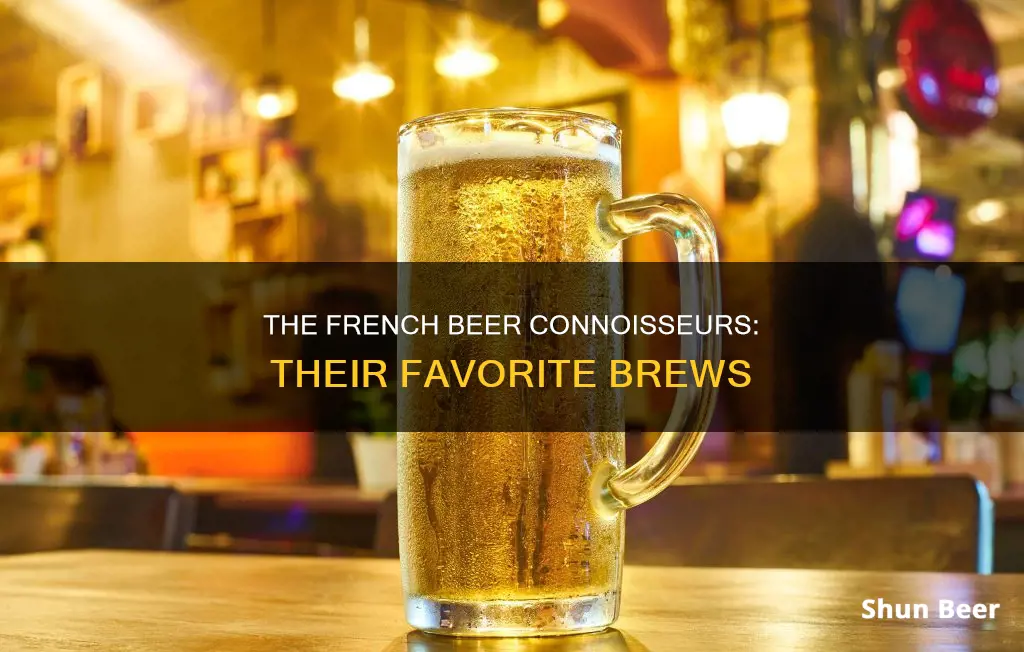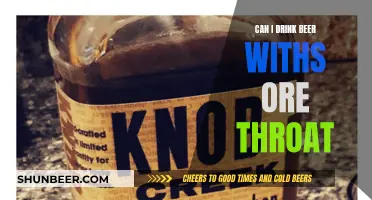
France is famous for its wine and liqueurs, but the French also have a taste for beer. In fact, beer is just as popular as wine in French bars and cafes. Most beer sold in France is pilsner lager, mass-produced by major breweries, although there are also traditional beer styles, such as top-fermented Bière de Garde, and a number of microbreweries.
The typical beer experience in France is different from the UK or North America. For example, when ordering a beer, you will be asked if you want un demi (a half-pint) or une pinte (a pint). Beer always comes with a glass, even if you order a bottle. And the cost of your beer will depend on where you choose to sit – it's cheaper to sit at the bar than at a table.
What You'll Learn

Beer drinking habits in France
France is traditionally associated with wine, but the French also have a strong thirst for beer. In fact, beer is just as popular to drink as wine at a cafe or bar.
The typical beer experience in France is different from that in North America or the UK, from how pints are ordered and served to the types of beers on tap.
Ordering Beer
When ordering a beer, you can choose the size of the glass. A bartender will ask if you want "un demi" (a half-pint costing around €3-4) or "une pinte" (a pint costing €6-8). The demi is always about half the price of the pint.
If you order a bottled beer, it will always be served with a glass. The cost of beer can also depend on where you sit. If you sit at the bar, your drink will be about €1 cheaper than if you sit at a table. In some establishments, such as upmarket restaurants on the Champs-Élysées, drinks will cost a few euros more if you sit outside.
Beer Choices
The most popular beers in France include Kronenbourg 1664, a light, crisp lager produced in Alsace; Grimbergen, a Belgian brand that makes ales and wheat beers; and Pelforth, a light pale ale produced in the Nord de Pas Calais region. Other beers that are frequently available include the Belgian wheat beer Leffe, the Belgian pilsner Stella Artois, and Dutch lagers Heineken and Grolsch.
At Christmas, some breweries produce speciality, hoppy beers, known as "les bieres de noel". Brasserie Schutzenberger and Meteor, two brewers from Alsace, produce popular "bière de Noël" that can be found in bars and supermarkets in December.
Beer Styles
The typical French beer from the Calais region is known as "bière de garde". These are amber or gold-coloured brews with a malty taste and high alcohol content. Some well-known "bière de garde" brewers include Trois Monts, Jenlain, and Brasserie Castelain.
Beer Consumption
While beer consumption in France is on the rise, the country still trails behind most of Europe. In 2017, the typical French person consumed 32 litres of beer per year, two litres more than four years earlier. The biggest consumers of beer in France are those in Normandy, followed by Grand Est and Brittany.
Beer is more of an aperitif or a drink to have with a light lunch. If you're invited to a fancy restaurant, drinking beer with your meal is likely to be a faux pas unless you're eating food served or cooked with beer.
Beer and Diverticulitis: What You Need to Know
You may want to see also

Beer drinking etiquette
While France is known for its wine, beer is just as popular in bars and cafes. Here are some tips for drinking beer the French way:
- Ordering a beer: When ordering a beer in France, you have the option to choose the size of your glass. You can ask for "un demi" (a half-pint) or "une pinte" (a pint). The price difference is significant, with a demi costing around €3-4 and a pinte costing €6-8.
- Beer and glass: If you order a bottled beer, the bartender will always provide you with a glass to pour your drink into. This is a cultural difference from some other countries, where bottled beer may be served without a glass.
- Cost considerations: In France, the cost of your beer can depend on where you choose to sit. Drinking at the bar is typically cheaper than sitting at a table, and some establishments may charge a few euros more for outdoor seating.
- Happy hours: Keep an eye out for happy hours, which offer discounts on drinks and are a welcome relief in expensive cities like Paris. Establishments with happy hours usually advertise this with a chalkboard or easel near the entrance.
- Mixing syrups: The French often mix syrups with their beer, adding flavours like peach, strawberry, lemon, ginger, black currant, or mint. You can also order a "un tango", which is a beer with a shot of grenadine syrup.
- Picon: Typical in Paris and northern France, "picon" is an aperitif made from fresh oranges and distilled alcohol. It is commonly mixed with beer, resulting in a sweet drink with a hint of citrus.
- Panaché: This drink is a refreshing mix of half beer and half carbonated lemonade, perfect for a hot summer day. A variation, called the "Biére Monaco", includes a shot of grenadine.
- On tap: In Paris, you'll commonly find beers like Kronenbourg 1664, Grimbergen, and Pelforth on tap. Other popular beers include Belgian brands like Leffe, Stella Artois, and Dutch lagers like Heineken and Grolsch.
- Traditional French beer: Biere de garde from the Calais region is an amber or gold-coloured brew with a malty taste and high alcohol content. Well-known brewers of this style include Trois Monts, Jenlain, and Brasserie Castelain.
- Craft beer: In recent years, there has been a rise in craft breweries and specialty beers in France, offering diverse tastes and innovative packaging. This has contributed to a change in consumption patterns, with beer becoming more common as an aperitif.
- Toasting: Before drinking, it is customary to wait for everyone's drink to be on the table. Once everyone has a full glass, a toast may be proposed. If a toast is given, it is considered rude not to drink, even if you only moisten your lips.
- Clinking glasses: When clinking glasses, it is customary to look into the eyes of the person you are toasting with. Be gentle when clinking, as it is considered dangerous and may be seen as a sign of drunkenness if you spill.
- Serving etiquette: In traditional French table etiquette, it is considered the man's job to fill the glasses of the women sitting next to them. However, this is changing, and in groups of women, one may simply pick up the bottle and serve everyone.
- Savouring your beer: Take your time and savour your beer slowly. It is not customary to fill your glass to the brim, as this allows the beer to breathe. Comment on your drink with an approving grin or a "Mmmm".
- Beer with dinner: Beer is typically considered a before-dinner drink or something to have with a light lunch. Drinking beer with dinner, especially in a fancy restaurant or when invited to someone's home, may be considered a faux pas unless you are eating food served or cooked with beer.
Beer and Boosters: What's Safe to Drink?
You may want to see also

Beer consumption in France
Although France is far more typically known for its wines and liqueurs, beer is just as popular to drink as wine at a cafe or bar. In fact, beer sales have been booming in recent years, bringing an end to the 36-year-long decline in beer consumption. In 2017, France marked the fourth consecutive year of increases in beer sales, with supermarkets, hotels, and restaurants reporting a 2.7% increase in the volume of beer sold. Larger retailers reported an increase of 8.1%.
The typical French person consumes 32 litres of beer each year, which is one of the lowest in Europe. However, this is two litres more than they did four years ago. The biggest consumers of beer in France are those in Normandy, followed by those in Grand Est and Brittany.
Beer Culture in France
Beer is more commonly consumed as an aperitif or with a light lunch in France. Drinking beer with dinner, especially in a fancy restaurant or someone's home, is often considered a faux pas unless you are eating food served or cooked with beer. Beer is also commonly served with a glass, even if it is bottled.
Beer Types in France
Most beer sold in France is pilsner lager, mass-produced by major breweries which control over 90% of the market. However, there are also traditional beer styles, such as top-fermented Bière de Garde, and a number of microbreweries.
Kronenbourg 1664, a light, crisp lager produced in Alsace, is commonly found on tap in Paris. Grimbergen, a brand from the Flanders region of Belgium, also makes a wide variety of popular ales and wheat beers. Pelforth, a light pale ale produced in the northern French region of Nord de Pas Calais, is another classic brew from northern France.
Ordering Beer in France
When ordering beer in France, you get to choose the type of beer and the size of the glass. A "demi" is a half-pint that costs around €3-4, while a "pinte" is a pint that costs €6-8. The "demi" almost always costs half the price of the "pinte". Beer is also commonly served with a glass, even if it is bottled.
Mixing Beer in France
The French are known for mixing a variety of syrups with their beer. Popular offerings include peach, strawberry, lemon, ginger, black currant, and mint. Beer can also be mixed with grenadine, a drink called "un tango", or lemonade, called a "panaché".
Metformin and Beer: Is It Safe to Drink Alcohol?
You may want to see also

Beer and breweries by region
While France may be more famous for its wine, beer is just as popular in bars and cafes. The typical beer experience in France is different from that in North America or the UK, from the way pints are ordered and served to the types of beers on tap.
Most beer sold in France is pilsner lager, mass-produced by major breweries, although traditional beer styles like top-fermented Bière de Garde are also available, and there are a number of microbreweries.
The Alsace-Lorraine region is the main beer-producing region of France, thanks to breweries in and around Strasbourg. These include Licorne (Karlsbräu), Kronenbourg, l'Espérance (Heineken International), Meteor, Schutzenberger, and Champigneulles (near Nancy). Hops are grown in Kochersberg and northern Alsace, and there are also several microbreweries in the area.
The Nord-Pas-de-Calais area, also known as French Flanders, has strong cultural ties to Belgium and a shared brewing heritage. The original Trois Brasseurs ("Three Brewers") brewpub is in Lille. Pelforth, a classic brew from northern France, was founded in 1914 in Mons-en-Barœul by three Lillois brewers.
Brittany has a long history of brewing, dating back to the 17th century. Young artisanal brewers are keeping a variety of beer types alive, such as Coreff de Morlaix, and Brasserie Lancelot produces specialities like Telenn Du, a beer made from buckwheat.
Bière de Garde ("beer for keeping") is a strong pale ale traditionally brewed in the Nord-Pas-de-Calais region. These beers were originally brewed in farmhouses during winter and spring to avoid problems with the yeast in summer. Most Bière de Garde brewers are small businesses, and the beers are typically copper or golden in colour.
Some well-known Bière de Garde brewers include Trois Monts, Jenlain, and Brasserie Castelain. Brasserie La Choulette's Abbaye de Vaucelles is described as being in the Bière de Garde style.
Other notable breweries and beers include:
- Fischer, an Alsatian beer brewed in Schiltigheim since 1862
- Goudale, a brewery that celebrated its 100th anniversary in 2019
- 3 Monts, a beer from French Flanders brewed in a brewery surrounded by three mountains
- Pietra, the first brewery to open in Corsica, a land of wines and spirits
- La Choulette, an artisanal beer brewed in one of the oldest breweries in the Nord-Pas-De-Calais region
- La Blonde d’Esquelbecq, a bière de garde brewed in the Thiriez brewery in Hauts-de-France
- Page 24, a beer brewed in the Saint Germain brewery in the Artois region of Nord-Pas-de-Calais
- Levrette, a craft beer from a Celtic brewery in Brittany
- La Débauche, a brewery in Angoulême that produces craft beers of all kinds
- Mont-Blanc, a brewery that produces several award-winning beers, including a white beer that has received three world beer awards
- Sainte-cru, a brewery in Alsace that produces anti-conformist beers, including the Apocalypse Now, a "voluptuous" Brown Beer
- La Cagole, a beer from Marseille now brewed in Douai in northern France
Beer and Penicillin: Safe Mix?
You may want to see also

Beer types and brands
While France is more typically known for its wines and liqueurs, beer is just as popular to drink as wine at a cafe or bar. In fact, in 2017, beer sales in France increased for the fourth consecutive year, with supermarkets, hotels, and restaurants reporting a 2.7% increase in the volume of beer sold.
Most beer sold in France is pilsner lager, mass-produced by major breweries that control over 90% of the market. However, there are also traditional beer styles, such as top-fermented Bière de Garde, and a number of microbreweries.
Beer Types
Lager
Lager is the most common type of beer sold in France. Pilsner lager, produced by major breweries, accounts for over 90% of the market. Kronenbourg 1664, for example, is a popular light, crisp lager produced in Alsace.
Ale
Ale is another type of beer commonly found in France. Pelforth, a classic brew from northern France, is a light pale ale produced in the Nord de Pas Calais region.
Bière de Garde
Bière de Garde is a traditional French beer style, typically amber or gold in colour with a malty taste and high alcohol content. It is often brewed and consumed in the Nord-Pas-de-Calais region of France.
Wheat Beer
French wheat beers are made by a number of large and small brewers and are not associated with any particular tradition. Examples include Blanc (5% ABV) from the Kronenbourg brewery and Pietra Colomba Biere Blanche, brewed with Corsican herbs.
Speciality Beers
In recent years, there has been a growing trend towards speciality beers in France, including non-alcoholic beers, aromatised beers, and artisanal beers. These beers often have more sophisticated flavours and diverse tastes, appealing to a wider range of consumers.
Beer Brands
Kronenbourg
Kronenbourg is a major French brewery, producing a range of beers including Kronenbourg 1664, a popular light lager, and Blanc, a wheat beer.
Pelforth
Pelforth is a French brewery founded in 1914 in Nord de Pas Calais. They are known for their light pale ale, as well as other speciality beers such as Pelforth Amber and George Killian's Biere Rousse, an Irish red ale.
Grimbergen
Grimbergen is a Belgian brand that produces a wide variety of popular ales and wheat beers.
Leffe
Leffe is a Belgian brand that brews a range of wheat beers.
Stella Artois
Stella Artois is a well-known Belgian pilsner that is commonly found in France.
Heineken
Heineken is a Dutch lager that is widely available in France. Heineken International also owns several breweries in France, including l'Espérance near Strasbourg.
Brasserie de Saint-Sylvestre
Brasserie de Saint-Sylvestre is a Bière de Garde brewery in the Nord-Pas-de-Calais region, known for its seasonal beers.
Trois Monts
Trois Monts is another well-known Bière de Garde brewery, producing beers with an ABV of 8.5%.
Brasserie Castelain
Brasserie Castelain is a Bière de Garde brewery that offers a range of beers, including Ch'Ti Blonde/Ambrée and Jenlain.
Root Beer: Healthy Beverage Choice or Not?
You may want to see also
Frequently asked questions
The most common beer sold in France is pilsner lager, mass-produced by major breweries. However, there are also traditional beer styles, such as top-fermented Bière de Garde, and a number of microbreweries. Some popular beers include Kronenbourg 1664, Grimbergen, and Pelforth.
Beer is widely available in France and is just as popular to drink as wine at cafes and bars. Establishments selling a wide selection of bottled and draught beers can be found in urban areas.
Beer is typically consumed as an aperitif or with a light lunch. It is not customary to drink beer with dinner unless it is paired with specific food served or cooked with beer.
In France, it is customary to be served a glass with a bottled beer. The cost of beer can also depend on where you choose to sit, with drinks at the bar being cheaper than at a table.







